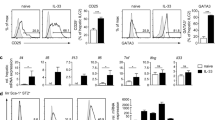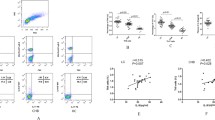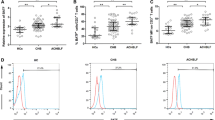Abstract
Background
Local production of cytokines within the liver may play a pivotal role in the regulation of pathophysiological processes during inflammation. CD4+ T cells are regarded as the most prolific cytokine producers. The purpose of this study was to quantify intrahepatic expression of Th1, Th2, Th17, and Treg-associated cytokines or transcription factors in patients with acute hepatitis B or chronic hepatitis B (CHB) and to analyze their relative roles in the promotion and regulation of hepatitis B virus (HBV)-associated liver diseases.
Methods
Distribution and expression of IL-17, IFN-γ, IL-4, Foxp3, and other cytokines in liver tissues were detected by immunohistochemistry and real-time quantitative PCR. Patients with hepatitis B were compared with patients with chronic hepatitis C, primary biliary cirrhosis, alcoholic liver cirrhosis, and healthy controls.
Results
The frequencies of intrahepatic IL-17 and IFN-γ-producing cells in patients with HBV-associated liver dysfunction were much higher than that of IL-4 and Foxp3-positive cells. The level of the IL-17/IFN-γ-positive cell ratio of patients with Child–Pugh class C (1.57 ± 0.09) was much higher than that of patients with Child–Pugh class B (1.00 ± 0.02) or A (0.93 ± 0.05). There are more IL-17-producing cells than IFN-γ-producing cells accumulating in the liver with severe hepatocellular damage. Liver IL-17-producing cell infiltration was positively associated with the grade of liver inflammation in CHB and positively correlated to intrahepatic IL-8 expression (r = 0.801, p < 0.01) or neutrophil infiltration (r = 0.917, p < 0.01).
Conclusions
These results suggest that the balance of effector CD4+ Th responses (Th17 and Th1 responses) and regulatory response is an important element of immune regulation. Inappropriate, excessive, and non-specific Th17 and Th1 effector responses may be involved in the pathogenesis of HBV-associated liver inflammation and hepatocellular damage. Th17 response, especially, may exacerbate the inflammatory processes leading to liver failure. IL-17-mediating liver neutrophil recruitment via induction of IL-8 may be one potential mechanism of liver injury in patients with hepatitis B. An improved understanding of the factors that influence the differentiation and function of these cell types in vivo will be of great importance to the future development of immune therapies in HBV-associated liver disease.





Similar content being viewed by others
Reference
Bettelli E, Carrier YJ, Gao WD, Korn T, Strom TB, Oukka M, et al. Reciprocal developmental pathways for the generation of pathogenic effector T(H)17 and regulatory T cells. Nature. 2006;441(7090):235–8.
Chisari FV, Hepatitis-B FC. Virus immunopathogenesis. Annu Rev Immunol. 1995;13:29–60.
Chisari FV, Ferrari C. Hepatitis B virus immunopathogenesis. Annu Rev Immunol. 1995;13:29–60.
Crispe IN. The liver as a lymphoid organ. Annu Rev Immunol. 2009;27:147–63.
Czaja AJ, Cookson S, Constantini PK, Clare M, Underhill JA, Donaldson PT. Cytokine polymorphisms associated with clinical features and treatment outcome in type 1 autoimmune hepatitis. Gastroenterology. 1999;117(3):645–52.
Fossiez F, Banchereau J, Murray R, Van Kooten C, Garrone P, Lebecque S. Interleukin-17. Int Rev Immunol. 1998;16(5–6):541–51.
Goodman ZD. Grading and staging systems for inflammation and fibrosis in chronic liver diseases. Journal of Hepatology. 2007;47(4):598–607.
Harrington LE, Hatton RD, Mangan PR, Turner H, Murphy TL, Murphy KM, et al. Interleukin 17-producing CD4+ effector T cells develop via a lineage distinct from the T helper type 1 and 2 lineages. Nat Immunol. 2005;6(11):1123–32.
Jaeschke H, Hasegawa T. Role of neutrophils in acute inflammatory liver injury. Liver Int. 2006;26(8):912–9.
Korn T, Bettelli E, Oukka M, Kuchroo VK. IL-17 and Th17 Cells. Annu Rev Immunol. 2009;27:485–517.
Koziel MJ. The immunopathogenesis of HBV infection. Antivir Ther. 1998;3 Suppl 3:13–24.
Laan M, Cui ZH, Hoshino H, Lotvall J, Sjostrand M, Gruenert DC, et al. Neutrophil recruitment by human IL-17 via C-X-C chemokine release in the airways. J Immunol. 1999;162(4):2347–52.
Lan RYZ, Salunga TL, Tsuneyama K, Lian ZX, Yang GX, Hsu W, et al. Hepatic IL-17 responses in human and murine primary biliary cirrhosis. J Autoimmun. 2009;32(1):43–51.
Lemmers A, Moreno C, Gustot T, Marechal R, Degre D, Demetter P, et al. The interleukin-17 pathway is involved in human alcoholic liver disease. Hepatology. 2009;49(2):646–57.
Liang TJ. Hepatitis B: the virus and disease. Hepatology. 2009;49(5 Suppl):S13–21.
Linden A. Role of interleukin-17 and the neutrophil in asthma. Int Arch Allergy Immunol. 2001;126(3):179–84.
Lohr HF, Weber W, Schlaak J, Goergen B, Zumbuschenfelde KHM, Gerken G. Proliferative response of CD4(+) T-cells and hepatitis-B virus clearance in chronic hepatitis with or without hepatitis -B E-minus hepatitis-B virus mutants. Hepatology. 1995;22(1):61–8.
McMahon BJ. The natural history of chronic hepatitis B virus infection. Hepatology. 2009;49(5 Suppl):S45–55.
Nishimura T, Ohta A. A critical role for antigen-specific Th1 cells in acute liver injury in mice. J Immunol. 1999;162(11):6503–9.
Park H, Li Z, Yang XO, Chang SH, Nurieva R, Wang YH, et al. A distinct lineage of CD4 T cells regulates tissue inflammation by producing interleukin 17. Nat Immunol. 2005;6(11):1133–41.
Penna A, DelPrete G, Cavalli A, Bertoletti A, Delios MM, Sorrentino R, et al. Predominant T-helper 1 cytokine profile of hepatitis B virus nucleocapsid-specific T cells in acute self-limited hepatitis B. Hepatology. 1997;25(4):1022–7.
Rehermann B, Nascimbeni M. Immunology of hepatitis B virus and hepatitis C virus infection. Nat Rev Immunol. 2005;5(3):215–29.
Ren F, Hino K, Yamaguchi Y, Funatsuki K, Hayashi A, Ishiko H, et al. Cytokine-dependent anti-viral role of CD4-positive T cells in therapeutic vaccination against chronic hepatitis B viral infection. J Med Virol. 2003;71(3):376–84.
Rossol S, Marinos G, Carucci P, Singer MV, Williams R, Naoumov NV. Interleukin-12 induction of Th1 cytokines is important for viral clearance in chronic hepatitis B. J Clin Invest. 1997;99(12):3025–33.
Steinman L. A brief history of T(H)17, the first major revision in the T(H)1/T(H)2 hypothesis of T cell-mediated tissue damage. Nat Med. 2007;13(2):139–45.
Takahashi H, Zeniya M, Watanabe F, Hayashi A, Hokari A, Aizawa Y, et al. Significance of intracellular Th1/Th2 cytokine analysis in chronic viral hepatitis. Hepatology. 1997;26(4):1926–6.
Tesmer LA, Lundy SK, Sarkar S, Fox DA. Th17 cells in human disease. Immunol Rev. 2008;223:87–113.
Trinchieri G. Interleukin-12: a proinflammatory cytokine with immunoregulatory functions that bridge innate resistance and antigen-specific adaptive immunity. Annu Rev Immunol. 1995;13:251–76.
Vierling JM. The immunology of hepatitis B. Clin Liver Dis. 2007;11(4):727–59. vii-viii.
Wieland SF, Chisari FV. Stealth and cunning: hepatitis B and hepatitis C viruses. J Virol. 2005;79(15):9369–80.
Xiao MJ, Wang CH, Zhang JH, Li ZG, Zhao XQ, Qin ZH. IFN gamma promotes papilloma development by up-regulating Th17-associated inflammation. Cancer Res. 2009;69(5):2010–7.
Xu XW, Lu MH, Tan DM. Association between tumour necrosis factor gene polymorphisms and the clinical types of patients with chronic hepatitis B virus infection. Clin Microbiol Infect. 2005;11(1):52–6.
Yasumi Y, Takikawa Y, Endo R, Suzuki K. Interleukin-17 as a new marker of severity of acute hepatic injury. Hepatol Res. 2007;37(4):248–54.
Zhang F, Wu LM, Zhou L, Chen QX, Xie HY, Feng XW, et al. Predictive value of expression and promoter hypermethylation of XAF1 in hepatitis B virus-associated hepatocellular carcinoma treated with transplantation. Ann Surg Oncol. 2008;15(12):3494–502.
Zhang JP, Yan J, Xu J, Pang XH, Chen MS, Li L, et al. Increased intratumoral IL-17-producing cells correlate with poor survival in hepatocellular carcinoma patients. J Hepatol. 2009;50(5):980–9.
Zhang JY, Zhang Z, Lin F, Zou ZS, Xu RN, Jin L, et al. Interleukin-17-producing CD4(+) T cells increase with severity of liver damage in patients with chronic hepatitis B. Hepatology. 2010;51(1):81–91.
Sponsor and grant acknowledgements
This work was supported by grants from the National Basic Research Program of China (2009CB522403), National Natural Science Foundation of China (No. 30972795), and National Science and Technology Major Project of China (No. 2008ZX10002-22).
Author information
Authors and Affiliations
Corresponding author
Rights and permissions
About this article
Cite this article
Ye, Y., Xie, X., Yu, J. et al. Involvement of Th17 and Th1 Effector Responses in Patients with Hepatitis B. J Clin Immunol 30, 546–555 (2010). https://doi.org/10.1007/s10875-010-9416-3
Received:
Accepted:
Published:
Issue Date:
DOI: https://doi.org/10.1007/s10875-010-9416-3




